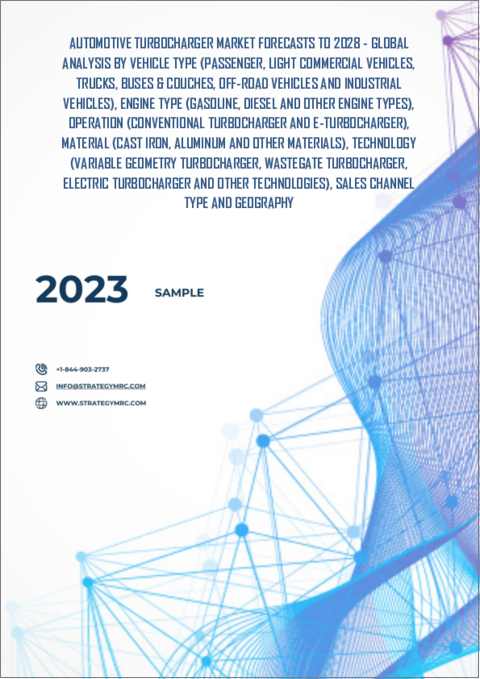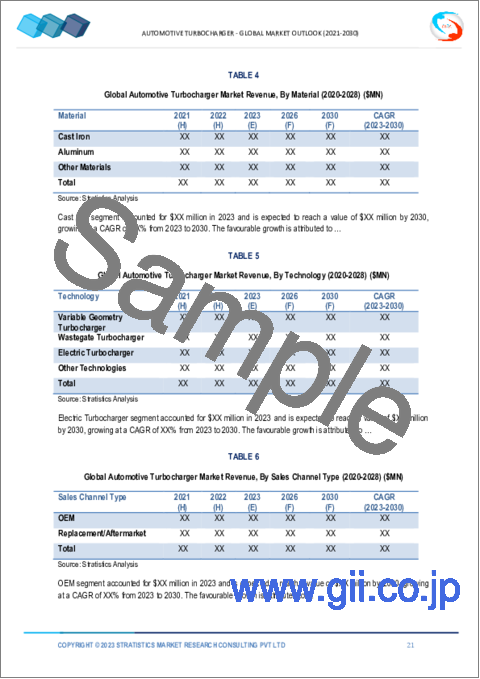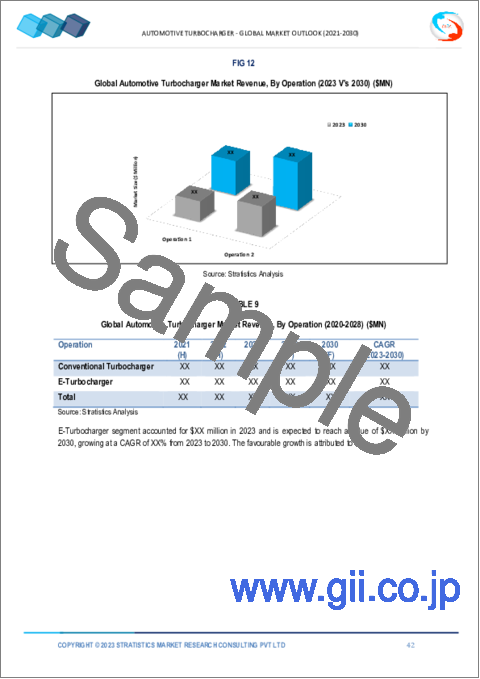|
|
市場調査レポート
商品コード
1235958
自動車用ターボチャージャーの世界市場:2028年までの予測- 車両タイプ、エンジンタイプ、動作、材料、技術、販売チャネルタイプ、地域別Automotive Turbocharger Market Forecasts to 2028 - Global Analysis By Vehicle Type, Engine Type, Operation, Material, Technology, Sales Channel Type and Geography |
||||||
|
● お客様のご希望に応じて、既存データの加工や未掲載情報(例:国別セグメント)の追加などの対応が可能です。 詳細はお問い合わせください。 |
|||||||
| 自動車用ターボチャージャーの世界市場:2028年までの予測- 車両タイプ、エンジンタイプ、動作、材料、技術、販売チャネルタイプ、地域別 |
|
出版日: 2023年03月03日
発行: Stratistics Market Research Consulting
ページ情報: 英文 175+ Pages
納期: 2~3営業日
|
- 全表示
- 概要
- 図表
- 目次
Stratistics MRCによると、自動車用ターボチャージャーの世界市場は、2022年に124億9000万米ドルを占め、2028年には216億5000万米ドルに達すると予測され、予測期間中に9.6%のCAGRで成長するとされています。
エンジンの効率は、現代の自動車に不可欠な部品とみなされているターボチャージャーによって向上します。タービンの動力源として、燃焼時に発生するエンジン排ガスを利用するシステムです。このタービンを軸に、コンプレッサーホイールを回転させます。外気を取り込んで圧縮し、コンプレッサーホイールを介してエンジンに送り込みます。より多くのパワーと燃料の節約で、圧縮された空気はより効果的に燃料を燃焼させます。
ATMによれば、タンチョンのセレンダ工場でCKD現地組立されるビガス・プロは、マレーシアで販売されるピックアップトラックの中で、新しい価値を提案するものです。パワーは、可変ジオメトリーターボチャージャーを備えた「プーマ」2.0リッターターボディーゼルエンジンを搭載しています。
市場力学
促進要因
促進要因:燃費向上への要求の高まり
自動車用ターボチャージャーは、ICエンジンの性能と効率を高めるためのタービン駆動の誘導装置です。車両の空気圧で出力が維持できない場合に、より多くの燃料を燃焼室に送り込むために導入されます。自動車メーカーは、化石燃料エンジンをできるだけクリーンな状態に保つために、ターボチャージャーを貴重な商品とみなしています。市場拡大の主な要因は、都市化の進展、工業化、道路インフラの建設、世界の生活水準の向上です。
阻害要因
電気自動車の普及率上昇
世界の自動車産業において、電気自動車は従来のガソリン自動車に取って代わりつつあります。大気汚染や地球温暖化の危機は、自動車の燃料がもたらす排出ガスの増加によって悪化しています。有名な自動車メーカーは、再生可能エネルギーの方向へますます進んでいます。自動車メーカーは、電気エネルギーを採用し、最先端技術を搭載した自動車を作るために、研究に幅広く投資しています。ゼロエミッション車への嗜好が高まり、市場の成長が阻害される可能性があります。
機会
自動車の販売と生産の増加
自動車産業の成長要因は、都市化の進展、工業化、道路インフラの整備、生活水準の向上などです。また、可処分所得の増加も自動車市場を牽引しています。自動車用ターボチャージャーの市場は、最終的には低排出ガス車や低燃費車の推進によって押し上げられることになります。自動車における高度な技術の革新と創造、最新技術を搭載した自動車の消費者への提供、そして市場での強い地位の維持のために、有名な自動車製造企業は、市場成長を促進することで実質的に調査に費やしています。
脅威
高いメンテナンスコストと、より多くの冷却油の必要性
エンジンにターボチャージャーを追加することはメリットがありますが、その分システムが過酷になり、システムの消耗が激しくなる傾向があります。ターボチャージャーから排出される排気ガスは、1200Fもの高温に耐える必要があります。そのため、ターボチャージャーの冷却を維持するために、冷却オイルを頻繁に循環させることが重要です。そのため、ターボチャージャーを搭載したエンジンでは、冷却オイルの使用量が多くなり、メンテナンス費用がかさみます。また、ターボチャージャーのメンテナンスが不十分な場合、エンジン冷却油の負担が大きくなり、早期故障につながる可能性があるため、市場の妨げとなります。
COVID-19の影響
COVID-19の流行は、メーカーが生産ラインの停止を余儀なくされ、景気を悪化させたため、この分野に影響を与えました。車両の移動がほとんどなかったため、既存の車両に装着される予備ターボチャージャーや新車に装着される新ターボチャージャーの新しい要件はありません。車両の移動が基本的になかったため、新車に装着されるターボチャージャーや、以前からある車両に交換される予備のターボチャージャーに対する新たな要求がなかったのです。そのため、車載用ターボチャージャーの世界市場は縮小傾向にあると思われます。
予測期間中、ガソリンセグメントが最も大きくなると予想される
ガソリンエンジンのターボチャージャーは、内燃機関により多くの空気を送り込むことができるため、ガソリン分野は有利に成長すると推定されます。ガソリンエンジンのターボチャージャーは、内燃機関に空気を送り込むことで、排気ガスの酸素濃度を高め、燃焼した燃料を燃焼させ、より大きなパワーを得ることができます。つまり、エンジンの回転中にシリンダー内の圧力を高くすることで、容量が制限されているエンジンの性能を向上させることができるのです。ガソリンエンジン用ターボチャージャーは、火花点火式のガソリンエンジンとディーゼルエンジンに対応していますが、大型トラックなど圧縮天然ガス(CNG)で走る車両は性能が低いため、ガソリンエンジン用ターボチャージャーは市場での用途が拡大しているため利用されています。
予測期間中、可変ジオメトリーターボチャージャーのCAGRが最も高くなると予想されます。
自動車用可変ジオメトリーターボチャージャーの市場は、電動ターボチャージャーを中心に拡大しているため、予測期間中に可変ジオメトリーターボチャージャーセグメントが最も速いCAGR成長を遂げると予測されます。また、ガソリンエンジン搭載の乗用車に対する消費者の需要の高まりや、排出ガス規制の施行に伴う公害基準の引き下げが、市場の拡大を後押ししています。しかし、自動車用可変容量型ターボチャージャーは、高いメンテナンスコスト、冷却油の使用量の増加、自動車生産の減少などの制約があり、またターボラグが市場拡大の脅威となっています。
最もシェアの高い地域
アジア太平洋地域は、予測期間中、最大の市場シェアを占めると予想されます。これは、中国やインドなど、自動車販売・製造のトップクラスにある経済成長著しい国々の存在により、この地域のターボチャージャー市場が拡大しているためです。急速な都市化、工業化の進展、インフラの整備、可処分所得の増加などが市場拡大の主な要因となっています。
CAGRが最も高い地域
ターボチャージャーの高度な技術の迅速な導入により、予測期間中、欧州のCAGRが最も高くなると予測されます。また、米国では環境保護庁(EPA)により、燃料の排出を制限するための厳しい規則や要件が実施されています。政府は、自動車メーカーに対して、よりクリーンで燃費の良いエンジンを作ることを義務付けています。自動車のエンジン改造やパフォーマンスチューニングのような欧州の進歩は勢いを増しており、メーカーはこれらの動向をより優れた自動車用ターボチャージャーの製造に取り入れることで対応しており、この地域の市場成長を牽引しています。
主な発展
2023年1月、BoschはHusqvarnaの約12%の株式を取得することに合意。HusqvarnaにはGardena子会社とそのFlymo brandも含まれ、両社はボッシュ・パワーツールズ部門の「Power for All Alliance」のパートナーでもあります。
2022年12月、ABBはBolidenと提携し、工業製品のカーボンフットプリントを削減、その目的は、温室効果ガス(GHG)排出量を削減しながら、より循環型の経済への移行を推進すること。
2022年9月、ABBがPowerTech Converterを買収し、トラクションの提供を拡大、ABBとPTCが共同で、よりエネルギー効率の高いソリューションの革新と開発に取り組む」とABBのトラクション部門社長のEdgar Kellerは述べています。
2022年8月、ABBとHydrogen Optimizedは戦略的投資を含む水素パートナーシップを拡大、組み合わせた技術提供にはHydrogen OptimizedのRuggedCell(TM)高出力水電解装置とABBの高出力整流器が含まれます。
本レポートが提供するもの
- 地域別および国別セグメントの市場シェア評価
- 新規参入企業への戦略的提言
- 2020年、2021年、2022年、2025年、2028年の市場データを網羅
- 市場促進要因(市場動向、制約要因、機会、脅威、課題、投資機会、推奨事項など)
- 市場推定に基づく主要なビジネスセグメントにおける戦略的な提言
- 競合情勢とその動向
- 詳細な戦略、財務、最近の動向を含む企業プロファイル
- サプライチェーンの動向は、最新の技術進歩をマッピングしています。
無料カスタマイズの提供
本レポートをご購入いただいたお客様には、以下の無料カスタマイズオプションのいずれかをご提供いたします。
- 企業プロファイルの作成
- 追加市場企業の包括的なプロファイリング(最大3社まで)
- 主要企業のSWOT分析(3社まで)
- 地域別セグメント
- お客様のご希望に応じて、主要国の市場推計・予測・CAGRを提供(注:フィージビリティチェック別。)
- 競合ベンチマーキング
- 製品ポートフォリオ、地理的プレゼンス、戦略的提携に基づく主要企業のベンチマーキング
目次
第1章 エグゼクティブサマリー
第2章 序文
- 概要
- ステークホルダー
- 調査範囲
- 調査手法
- データマイニング
- データ分析
- データ検証
- 調査アプローチ
- 調査情報源
- 1次調査情報源
- 2次調査情報源
- 仮定
第3章 市場動向分析
- 促進要因
- 抑制要因
- 機会
- 脅威
- 技術分析
- 新興市場
- COVID-19の影響
第4章 ポーターのファイブフォース分析
- 供給企業の交渉力
- 買い手の交渉力
- 代替品の脅威
- 新規参入業者の脅威
- 競争企業間の敵対関係
第5章 世界の自動車用ターボチャージャー市場:車両タイプ別
- 乗客
- ハッチバック
- セダン
- ユーティリティビークル
- 小型商用車
- トラック
- バスとソファ
- オフロード車
- 農業機器
- 建設機械
- 採掘設備
- 産業車両
第6章 世界の自動車用ターボチャージャー市場:エンジンタイプ別
- ガソリン
- ディーゼル
- 他のエンジンタイプ
第7章 世界の自動車用ターボチャージャー市場:事業別
- 従来のターボチャージャー
- Eターボチャージャー
第8章 世界の自動車用ターボチャージャー市場:材料別
- 鋳鉄
- アルミニウム
- その他の資料
第9章 世界の自動車用ターボチャージャー市場:技術別
- バリアブルジオメトリターボチャージャー
- ウェストゲートターボチャージャー
- 電動ターボチャージャー
- その他の技術
第10章 世界の自動車用ターボチャージャー市場:販売チャネル別
- OEM
- 交換/アフターマーケット
第11章 世界の自動車用ターボチャージャー市場:地域別
- 北米
- 米国
- カナダ
- メキシコ
- 欧州
- ドイツ
- 英国
- イタリア
- フランス
- スペイン
- その他欧州
- アジア太平洋地域
- 日本
- 中国
- インド
- オーストラリア
- ニュージーランド
- 韓国
- その他アジア太平洋地域
- 南米
- アルゼンチン
- ブラジル
- チリ
- その他南米
- 中東とアフリカ
- サウジアラビア
- アラブ首長国連邦
- カタール
- 南アフリカ
- その他中東
第12章 主な発展
- 契約、パートナーシップ、コラボレーション、合弁事業
- 買収と合併
- 新製品の発売
- 事業拡大
- その他の主要戦略
第13章 企業プロファイル
- BorgWarner Inc.
- Mitsubishi Heavy Industries Ltd
- Continental AG
- Garrett Motion Inc.
- IHI Corporation
- Rotomaster International
- Keyyang Precision Co., LTD
- Turbo Energy Private Limited
- BMTS Technology GmbH & Co. KG
- Magnum Performance Turbos
- Cummins Inc.
- Eaton Corporation PLC
- Honeywell International
- Precision Turbo & Engine Inc
- ABB
- Robert Bosch GmbH
- Marelli Corporation
List of Tables
- Table 1 Global Automotive Turbocharger Market Outlook, By Region (2020-2028) ($MN)
- Table 2 Global Automotive Turbocharger Market Outlook, By Vehicle Type (2020-2028) ($MN)
- Table 3 Global Automotive Turbocharger Market Outlook, By Passenger (2020-2028) ($MN)
- Table 4 Global Automotive Turbocharger Market Outlook, By Hatchback (2020-2028) ($MN)
- Table 5 Global Automotive Turbocharger Market Outlook, By Sedan (2020-2028) ($MN)
- Table 6 Global Automotive Turbocharger Market Outlook, By Utility Vehicles (2020-2028) ($MN)
- Table 7 Global Automotive Turbocharger Market Outlook, By Light Commercial Vehicles (2020-2028) ($MN)
- Table 8 Global Automotive Turbocharger Market Outlook, By Trucks (2020-2028) ($MN)
- Table 9 Global Automotive Turbocharger Market Outlook, By Buses & Couches (2020-2028) ($MN)
- Table 10 Global Automotive Turbocharger Market Outlook, By Off-Road Vehicles (2020-2028) ($MN)
- Table 11 Global Automotive Turbocharger Market Outlook, By Agricultural Equipments (2020-2028) ($MN)
- Table 12 Global Automotive Turbocharger Market Outlook, By Construction Equipments (2020-2028) ($MN)
- Table 13 Global Automotive Turbocharger Market Outlook, By Mining Equipments (2020-2028) ($MN)
- Table 14 Global Automotive Turbocharger Market Outlook, By Industrial Vehicles (2020-2028) ($MN)
- Table 15 Global Automotive Turbocharger Market Outlook, By Engine Type (2020-2028) ($MN)
- Table 16 Global Automotive Turbocharger Market Outlook, By Gasoline (2020-2028) ($MN)
- Table 17 Global Automotive Turbocharger Market Outlook, By Diesel (2020-2028) ($MN)
- Table 18 Global Automotive Turbocharger Market Outlook, By Other Engine Types (2020-2028) ($MN)
- Table 19 Global Automotive Turbocharger Market Outlook, By Operation (2020-2028) ($MN)
- Table 20 Global Automotive Turbocharger Market Outlook, By Conventional Turbocharger (2020-2028) ($MN)
- Table 21 Global Automotive Turbocharger Market Outlook, By E-Turbocharger (2020-2028) ($MN)
- Table 22 Global Automotive Turbocharger Market Outlook, By Material (2020-2028) ($MN)
- Table 23 Global Automotive Turbocharger Market Outlook, By Cast Iron (2020-2028) ($MN)
- Table 24 Global Automotive Turbocharger Market Outlook, By Aluminum (2020-2028) ($MN)
- Table 25 Global Automotive Turbocharger Market Outlook, By Other Materials (2020-2028) ($MN)
- Table 26 Global Automotive Turbocharger Market Outlook, By Technology (2020-2028) ($MN)
- Table 27 Global Automotive Turbocharger Market Outlook, By Variable Geometry Turbocharger (2020-2028) ($MN)
- Table 28 Global Automotive Turbocharger Market Outlook, By Wastegate Turbocharger (2020-2028) ($MN)
- Table 29 Global Automotive Turbocharger Market Outlook, By Electric Turbocharger (2020-2028) ($MN)
- Table 30 Global Automotive Turbocharger Market Outlook, By Other Technologies (2020-2028) ($MN)
- Table 31 Global Automotive Turbocharger Market Outlook, By Sales Channel Type (2020-2028) ($MN)
- Table 32 Global Automotive Turbocharger Market Outlook, By OEM (2020-2028) ($MN)
- Table 33 Global Automotive Turbocharger Market Outlook, By Replacement/Aftermarket (2020-2028) ($MN)
Note: Tables for North America, Europe, APAC, South America, and Middle East & Africa Regions are also represented in the same manner as above.
According to Stratistics MRC, the Global Automotive Turbocharger Market is accounted for $12.49 billion in 2022 and is expected to reach $21.65 billion by 2028 growing at a CAGR of 9.6% during the forecast period. The efficiency of the engine is increased by turbochargers, which are regarded as essential parts of modern automobiles. In order to power the turbine, the system uses engine exhaust gas produced during combustion. With the aid of a shaft, this turbine turns the compressor wheel. The outside air is drawn in, compressed, and sent to the engine via the compressor wheel. With more power and fuel savings, the compressed air burns the fuel more effectively.
According to ATM, the Vigus Pro, which is CKD locally assembled at Tan Chong's Serendah plant, is a new value proposition among pick-up trucks sold in Malaysia. Power comes from a 'Puma' 2.0-liter turbodiesel engine with a variable geometry turbocharger.
Market Dynamics:
Driver:
Increased demand for improved fuel economy
Automobile turbochargers are turbine-driven induction equipment that boosts the performance and efficiency of IC engines. If the vehicle's air pressure is unable to maintain the desired output, these devices are deployed to feed more fuel into the combustion chamber. Automobile manufacturers consider turbochargers to be a valuable commodity that they rely on to maintain fossil fuel engines as clean as possible. The main factors fuelling the market expansion are an increase in urbanisation; industrialization, the construction of road infrastructure, and an increase in the level of living globally are propelling the market growth.
Restraint:
Rise in the utilization of electric vehicles
Electric vehicles are replacing traditional gasoline vehicles in the worldwide automobile sector. The crisis of air pollution and global warming is being exacerbated by the rising emissions brought on by the fuels of the automobiles. The well-known auto manufacturers are moving more and more in the direction of renewable energy. Vehicle manufacturers are adopting the electric mode of energy and investing extensively in research to create vehicles with cutting-edge technologies. The market may suffer as a result of people's growing preference for zero-emission vehicles thereby hinder the growth of the market.
Opportunity:
Increasing automotive sales and production
The factors responsible of the automotive industry's growth are the rise of urbanisation, industrialisation, the development of road infrastructure, and an improvement in living standards. The automotive market is also being driven forward by the increase in disposable income. The market for automotive turbochargers is eventually being driven up by the push for low emission and fuel efficient vehicles. In order to innovate and create sophisticated technology in autos, provide their consumers with the newest technologically equipped vehicles, and maintain a strong market position, the well-known automotive manufacturing businesses are substantially spending in research by enhancing the market growth.
Threat:
High maintenance cost and more cooling oil requirements
Although adding a turbocharger to an engine offers advantages, the system tends to operate more arduously, causing system wear and tear. The exhaust gases from the turbocharger must tolerate heat up to 1200F. Thus, it becomes crucial to circulate cooling oil often in order to maintain the turbocharger's cooling. A turbocharged engine therefore requires more cooling oil, which raises the expense of maintenance. Additionally, inadequate turbocharger maintenance can result in early breakdowns that put more strain on the engine's engine cooling oil hamper the market.
COVID-19 Impact
The COVID-19 epidemic had an impact on the sector because it forced manufacturers to shut down production lines and weakened the economy. There were hardly any vehicle transfers, thus there were no new requirements for spare turbochargers to be fitted in existing vehicles or for new turbochargers to be installed in new vehicles. There were no new requirements for turbochargers to be installed in new cars and spare turbochargers to be replaced in previously existing vehicles because there were essentially no vehicle movements. Consequently, this is probably going to decline the global market for vehicle turbochargers.
The Gasoline segment is expected to be the largest during the forecast period
The Gasoline segment is estimated to have a lucrative growth, due to an internal combustion engine that can be forced to receive more air thanks to a gasoline engine turbocharger. By adding more air, the exhaust gas' oxygen content rises to a level where burned fuel may continue to ignite and provide more power. In other words, it improves performance of engines with restricted capacity by faking higher pressure inside the cylinders while the engine is running. Spark-ignited gasoline and diesel engine types are compatible with gasoline engine turbochargers, but big trucks and other vehicles that run on compressed natural gas (CNG) don't perform as well thus gasoline engine turbocharger are utilized due to their growing applications in the market.
The variable geometry turbocharger segment is expected to have the highest CAGR during the forecast period
The variable geometry turbocharger segment is anticipated to witness the fastest CAGR growth during the forecast period, due to the market for automobile variable geometry turbochargers is expanding mostly due to electric turbochargers. Additionally, rising consumer demand for gasoline-powered passenger automobiles and lowering pollution standards in impending emission laws boost market expansion. The automotive variable geometry turbocharger industry, however, is constrained by high maintenance costs, an increase in cooling oil use, and a decline in vehicle production, whilst turbo lag will pose a threat to market expansion.
Region with largest share:
Asia Pacific is projected to hold the largest market share during the forecast period owing to the market for turbochargers in this region is expanding as a result of the presence of some of the economies with the fastest economic growth, including China and India, which are the top nations for automobile sales and manufacturing. Rapid urbanisation, increased industrialisation, better infrastructure, and a rise in disposable income are the main drivers of market expansion.
Region with highest CAGR:
Europe is projected to have the highest CAGR over the forecast period, owing to the quick adoption of sophisticated technologies in turbochargers. Additionally, strict rules and requirements have been implemented by the Environmental Protection Agency (EPA) in the United States to limit fuel emission. The government has made it mandatory for automakers to create cleaner, more fuel-efficient engines. European advances like engine remapping and performance tuning for automobiles are gaining momentum, and manufacturers are responding by incorporating these trends into the creation of better car turbochargers which drives the market growth in this region.
Key players in the market
Some of the key players profiled in the Automotive Turbocharger Market include: BorgWarner Inc., Mitsubishi Heavy Industries Ltd, Continental AG, Garrett Motion Inc, IHI Corporation, Rotomaster International, Keyyang Precision Co., LTD, Turbo Energy Private Limited, BMTS Technology GmbH & Co. KG, Magnum Performance Turbos, Cummins Inc., Eaton Corporation PLC, Honeywell International, Precision Turbo & Engine Inc, ABB, Robert Bosch GmbH and Marelli Corporation
Key Developments:
In Jan 2023, Bosch agreed to acquire roughly 12 percent shares in Husqvarna in total, Husqvarna also includes the Gardena subsidiary and its Flymo brand, both of which are also partners in the Bosch Power Tools division's "Power for All Alliance".
In Dec 2022, ABB partners with Boliden to reduce carbon footprint of its industrial products, the aim is to reduce greenhouse gas (GHG) emissions while driving the transition to a more circular economy.
In Sep 2022, ABB to acquire PowerTech Converter to expand its traction offering, ABB and PTC's combined efforts to innovate and develop more energy efficient solutions," said Edgar Keller, President of ABB's Traction division.
In August 2022, ABB and Hydrogen Optimized expand hydrogen partnership, including a strategic investment; combined technological offerings will include Hydrogen Optimized's RuggedCell™ high-power water electrolyzers and ABB's high-power rectifiers.
Vehicle Types Covered:
- Passenger
- Light Commercial Vehicles
- Trucks
- Buses & Couches
- Off-Road Vehicles
- Industrial Vehicles
Engine Types Covered:
- Gasoline
- Diesel
- Other Engine Types
Operations Covered:
- Conventional Turbocharger
- E-Turbocharger
Materials Covered:
- Cast Iron
- Aluminum
- Other Materials
Technologies Covered:
- Variable Geometry Turbocharger
- Wastegate Turbocharger
- Electric Turbocharger
- Other Technologies
Sales Channel Types Covered:
- OEM
- Replacement/Aftermarket
Regions Covered:
- North America
- US
- Canada
- Mexico
- Europe
- Germany
- UK
- Italy
- France
- Spain
- Rest of Europe
- Asia Pacific
- Japan
- China
- India
- Australia
- New Zealand
- South Korea
- Rest of Asia Pacific
- South America
- Argentina
- Brazil
- Chile
- Rest of South America
- Middle East & Africa
- Saudi Arabia
- UAE
- Qatar
- South Africa
- Rest of Middle East & Africa
What our report offers:
- Market share assessments for the regional and country-level segments
- Strategic recommendations for the new entrants
- Covers Market data for the years 2020, 2021, 2022, 2025, and 2028
- Market Trends (Drivers, Constraints, Opportunities, Threats, Challenges, Investment Opportunities, and recommendations)
- Strategic recommendations in key business segments based on the market estimations
- Competitive landscaping mapping the key common trends
- Company profiling with detailed strategies, financials, and recent developments
- Supply chain trends mapping the latest technological advancements
Free Customization Offerings:
All the customers of this report will be entitled to receive one of the following free customization options:
- Company Profiling
- Comprehensive profiling of additional market players (up to 3)
- SWOT Analysis of key players (up to 3)
- Regional Segmentation
- Market estimations, Forecasts and CAGR of any prominent country as per the client's interest (Note: Depends on feasibility check)
- Competitive Benchmarking
- Benchmarking of key players based on product portfolio, geographical presence, and strategic alliances
Table of Contents
1 Executive Summary
2 Preface
- 2.1 Abstract
- 2.2 Stake Holders
- 2.3 Research Scope
- 2.4 Research Methodology
- 2.4.1 Data Mining
- 2.4.2 Data Analysis
- 2.4.3 Data Validation
- 2.4.4 Research Approach
- 2.5 Research Sources
- 2.5.1 Primary Research Sources
- 2.5.2 Secondary Research Sources
- 2.5.3 Assumptions
3 Market Trend Analysis
- 3.1 Introduction
- 3.2 Drivers
- 3.3 Restraints
- 3.4 Opportunities
- 3.5 Threats
- 3.6 Technology Analysis
- 3.7 Emerging Markets
- 3.8 Impact of Covid-19
4 Porters Five Force Analysis
- 4.1 Bargaining power of suppliers
- 4.2 Bargaining power of buyers
- 4.3 Threat of substitutes
- 4.4 Threat of new entrants
- 4.5 Competitive rivalry
5 Global Automotive Turbocharger Market, By Vehicle Type
- 5.1 Introduction
- 5.2 Passenger
- 5.2.1 Hatchback
- 5.2.2 Sedan
- 5.2.3 Utility Vehicles
- 5.3 Light Commercial Vehicles
- 5.4 Trucks
- 5.5 Buses & Couches
- 5.6 Off-Road Vehicles
- 5.6.1 Agricultural Equipments
- 5.6.2 Construction Equipments
- 5.6.3 Mining Equipments
- 5.7 Industrial Vehicles
6 Global Automotive Turbocharger Market, By Engine Type
- 6.1 Introduction
- 6.2 Gasoline
- 6.3 Diesel
- 6.4 Other Engine Types
7 Global Automotive Turbocharger Market, By Operation
- 7.1 Introduction
- 7.2 Conventional Turbocharger
- 7.3 E-Turbocharger
8 Global Automotive Turbocharger Market, By Material
- 8.1 Introduction
- 8.2 Cast Iron
- 8.3 Aluminum
- 8.4 Other Materials
9 Global Automotive Turbocharger Market, By Technology
- 9.1 Introduction
- 9.2 Variable Geometry Turbocharger
- 9.3 Wastegate Turbocharger
- 9.4 Electric Turbocharger
- 9.5 Other Technologies
10 Global Automotive Turbocharger Market, By Sales Channel Type
- 10.1 Introduction
- 10.2 OEM
- 10.3 Replacement/Aftermarket
11 Global Automotive Turbocharger Market, By Geography
- 11.1 Introduction
- 11.2 North America
- 11.2.1 US
- 11.2.2 Canada
- 11.2.3 Mexico
- 11.3 Europe
- 11.3.1 Germany
- 11.3.2 UK
- 11.3.3 Italy
- 11.3.4 France
- 11.3.5 Spain
- 11.3.6 Rest of Europe
- 11.4 Asia Pacific
- 11.4.1 Japan
- 11.4.2 China
- 11.4.3 India
- 11.4.4 Australia
- 11.4.5 New Zealand
- 11.4.6 South Korea
- 11.4.7 Rest of Asia Pacific
- 11.5 South America
- 11.5.1 Argentina
- 11.5.2 Brazil
- 11.5.3 Chile
- 11.5.4 Rest of South America
- 11.6 Middle East & Africa
- 11.6.1 Saudi Arabia
- 11.6.2 UAE
- 11.6.3 Qatar
- 11.6.4 South Africa
- 11.6.5 Rest of Middle East & Africa
12 Key Developments
- 12.1 Agreements, Partnerships, Collaborations and Joint Ventures
- 12.2 Acquisitions & Mergers
- 12.3 New Product Launch
- 12.4 Expansions
- 12.5 Other Key Strategies
13 Company Profiling
- 13.1 BorgWarner Inc.
- 13.2 Mitsubishi Heavy Industries Ltd
- 13.3 Continental AG
- 13.4 Garrett Motion Inc.
- 13.5 IHI Corporation
- 13.6 Rotomaster International
- 13.7 Keyyang Precision Co., LTD
- 13.8 Turbo Energy Private Limited
- 13.9 BMTS Technology GmbH & Co. KG
- 13.10 Magnum Performance Turbos
- 13.11 Cummins Inc.
- 13.12 Eaton Corporation PLC
- 13.13 Honeywell International
- 13.14 Precision Turbo & Engine Inc
- 13.15 ABB
- 13.16 Robert Bosch GmbH
- 13.17 Marelli Corporation




